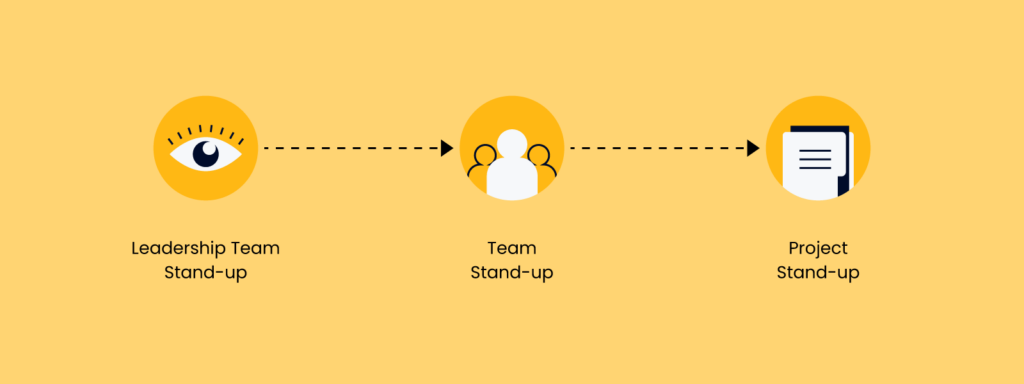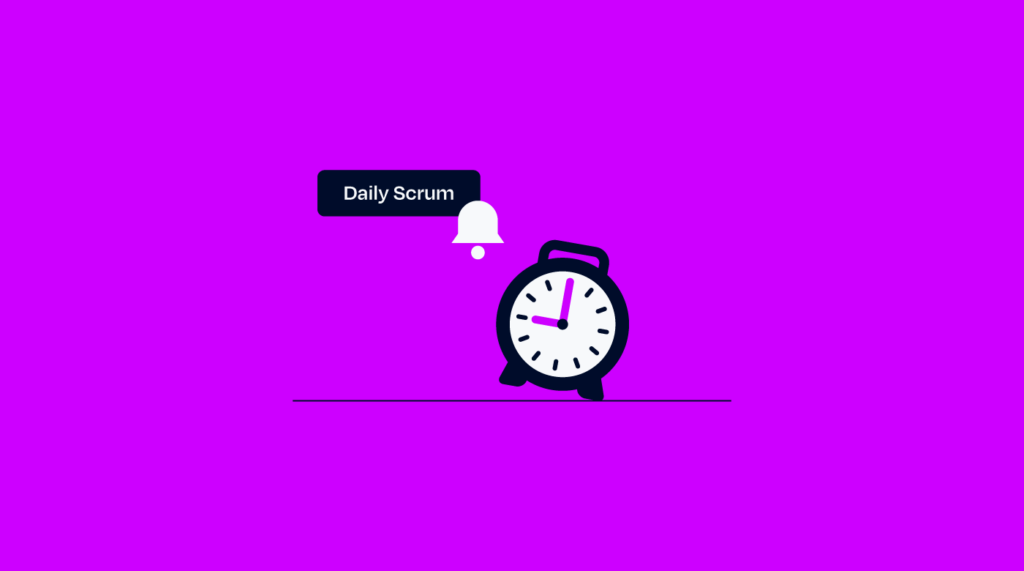If you're like most project managers or Scrum masters, you've probably found that daily stand-ups can be a helpful way to keep your team on track. You likely have set a meeting on your team’s calendar for 30 minutes to get together each day and talk about what’s going on.
It probably worked for a while, with you facilitating each session, but then it starts to fall apart. People start going on and on and sharing information that’s not relevant, taking up significant time, and the value of the meeting is diminished to the point where people stop attending consistently.
You can do better. Your team needs an effective sync. We’re going to fix this.
You might think, “Oh, daily stand-ups, that’s just a Scrum thing, right?” Wrong. Daily stand-ups can help any team stay aligned and move forward together.
Daily stand-ups are a staple of many project management and development processes, but they can often be ineffective and unproductive. Personally, I have a decade of experience navigating and facilitating numerous projects and teams, each with their own way of conducting stand-ups, syncs, and scrums.
I’m classically trained in both Agile and predictive project management methodologies, making me well-equipped to tackle this often contentious topic.
In this blog post, I'll explore how to run an effective daily stand-up meeting and get the most out of this important process. I'll also cover tips on agenda items, timing, and how to handle distractions during the meeting.
First, What Is A Daily Stand-up?
A daily stand-up is a meeting that occurs every day to help ensure that everyone is on the same page and knows what they need to do. It usually lasts around 10-15 minutes, and everyone in the project or Scrum team participates.
The goal of a daily stand-up is to get everyone on the same page, celebrate incremental progress, and help identify any potential roadblocks such that they can be resolved swiftly. Daily stand-ups are not only for agile teams or software development teams—they are for everyone!
In typical daily stand-ups, the team gathers together to each answer three short questions, (this is the stand-up meeting agenda):
- What did you do yesterday?
- What are you going to do today?
- What is blocking you from making progress?
As each member answers the three questions, any collaboration or opportunities to unblock members are noted for discussion after all members have shared.
Someone sharing a blocker might get a follow-up response from another member: “let’s talk; I think I can help you fix that.” This spurs a further discussion after the stand-up has met its primary objective.
In a best-case scenario, the members will meet briefly just after the stand-up to handle whatever it is that is blocking progress so everyone can go about their day and be as effective as possible.
Ta-da! That’s it! A daily stand-up is simple to learn, but tough to master with a team because teams are always changing, new issues arise, and working styles evolve. Don’t worry! We’ve got that covered too. Read on!
What should I call the session?
There are many names for this highly-effective meeting. Most often, I hear daily stand-up, the daily Scrum meeting, daily sync, check-in, download, or huddle. Whatever your team calls this session, be consistent with the name and make sure all participants understand the objective and structure of the meeting.
As you bring on new team members, you might even consider allowing them to observe one or two sessions before jumping in themselves to build confidence in how to participate best.
How to Run a Daily Stand-up
A daily stand-up is a short meeting that is typically held each workday at a set time (I prefer mornings, personally, but beware of different time zones), and its purpose is to keep everyone on the same page. The short meeting should last no longer than 10-15 minutes.
Getting Setup
If you’re the organizer of the session, find a time that works on everyone’s calendars consistently (note different time zones) and set a recurring 15 minute session. If you are meeting in person, reserve the same place or conference room for each meeting.
If your remote employees will be gathering in a virtual space (such as Zoom or another video conferencing tool), use the same meeting link for each occurrence and be sure to set the meeting to allow participants to join without the host in the event that you go on that much-deserved vacation.
Distributed teams might also choose to do asynchronous stand-ups, where team members answer the questions via an app like Slack at a time that works best for them (this is a great way to reduce the number of meetings you have to attend).
Facilitating the Session
Each stand-up should have a facilitator or someone who understands the objective of the short meeting and can help keep the team on-task. This can be someone who is nominated or named to the role, or a facilitator might find their voice naturally. Either scenario is okay.
To facilitate a successful daily stand-up, it's important to ensure that everyone is present and that the meeting stays on track. It's also important to set some ground rules, such as no laptops or cellphones allowed (for colocated teams) or a working agreement to not multitask (for hybrid or remote teams).
To kick off the session, gather the team and ask each participant to answer those three questions (yes, they are a bit templated) in about 3-minutes or less per person.
As the questions are answered, note any dependencies or opportunities to collaborate on unblocking and solving problems to allow the team to progress forward.
Once each participant is finished, either move on to the next in a logical order (round robin) or ask each person to select the next person at random (my personal preference, this keeps everyone engaged and on their toes if it might be their turn next!)
As you progress through the session, it's possible that participants will find something interesting to talk about that goes beyond answering the three questions above.
Many teams find value in using a “parking lot” to temporarily “park” discussions that are not aligned with the objective of the session but are valuable to handle afterward. After the session has met its objective, visit the parking lot to sort out anything that was left to handle as a group.
Once everyone has had a chance to answer the questions, and the session has met its objective, it's time to adjourn! Thank the team, wish them well, and encourage approachability, openness, and collaboration.
6 Benefits of Stand-up Meetings
Daily stand-ups make a world of difference to team effectiveness and fun! Here are a few specific benefits of investing in daily stand-ups:
1. Sense of Urgency
Holding a daily stand-up creates and upholds a sense of urgency for tasks and helps to encourage accountability for making progress towards goals each day.
2. Quick, Effective Communication
The daily stand-up is a quick, effective communication channel for team members to share updates and key highlights of their work with the rest of the team and get the support they need to move forward.
Nothing quite like asking the whole team for help at once vs. asking around via chat or, even worse, the dreaded shoulder tap that turns into a half-hour conversation.
3. Inspect, Adapt, and Align
The daily stand-up allows for a team to inspect, adapt, and align their work at a very rapid pace such that the team shouldn’t get too far off track from each other if they meet regularly.
Keeping the tight feedback loop makes people more confident that they are doing the right things and inspires confidence in leadership and key stakeholders that the right and most important things are being worked on at any given time.
4. Identify Blockers
Identifying and determining the next steps and action items for blockers or challenges to achieving the team’s goals is perhaps the most important part of the daily stand-up. Having an opportunity to raise an issue and ask for help quickly is exceptionally valuable.
Imagine if a blocker had to wait a full week before being raised in a team meeting! Keep teams moving forward effectively by identifying blockers rapidly in daily stand-up meetings and then swarming the right people on problem-solving swiftly so the team can move forward.
5. Foster Collaboration
People (generally) like to be helpful, especially when it comes to people they like. Daily stand-ups foster collaboration as teams feel involved and included in the work that's happening not just on their own desk, but on the desks of others.
For me, knowing what’s going on in other groups and what is most important for my colleagues helps me be informed about where we are as a group and how I can best support them.
Sometimes, I hear a teammate of mine is about to tackle something I have already done or have an example for—that’s an opportunity for me to help shorten their path to knowledge by sharing a guide or example that they would have otherwise needed to ask me for!
6. Build Team Morale
Humans are social creatures, and people like solving problems together. Daily stand-ups not only foster collaboration, but they also facilitate team building by helping people feel like they are not alone, and that they are part of a team.
This increase in social connectedness and support improves morale and emotional wellbeing of all participants with an added benefit of building relationships that will certainly come in handy when something breaks and the team needs to swarm to fix something in a pinch!
6 Tips To Make Your Stand-Ups More Effective
Sometimes, stand-ups become too routine, and laziness takes over, so your daily sync goes awry. We forget the targeted outcome and benefits of collaboration, understanding, and planning, and instead become standoffish as team members compete for time and attention, or worst of all, stop engaging altogether.
Here are five tips to make your daily stand-up less of a stand-off; avoid some common mistakes with these 6 tips to make your stand-ups more effective.
1. Change Your Language
The three questions themselves sound status-like—we’re trying to avoid that! Try changing a few keywords, and the intent to communicate obstacles, progress, and planning toward goal attainment is easily achieved.
- What did I accomplish yesterday that brought us closer to our goals?
- What will I accomplish today that will bring us closer to our goals?
- What is blocking me from achieving our goals?
This change also eliminates the conversation of “I attended a meeting,” “I ate pizza for lunch,” “I took my dog for a walk (wait, weren’t you at work?!)”
2. Eliminate Waste
If you’re finding your daily meeting is taking too long or ends up with too much chit-chat, how about trying these three more focused questions instead:
- What have you accomplished that we can celebrate?
- What does the entire team need to know is happening next?
- What do you need help with?
It still achieves the same outcome but eliminates some of the conversations that are not directly related to achieving collective goals. Does the team need to know what you ate for lunch? No. Do they need to know what meeting you attended? Maybe. What do you need help with? Yes!
3. Reduce Distractions
This is an easy one, but with some variations depending on the team’s working location. If people are looking out a window and not paying attention to what’s going on, move the group away from the window or pull a shade down to block it.
Are other teams too loud? Move to a different area. Teams looking at computers and multitasking? Try a different space or medium. Not listening? Have everyone close their eyes in-person or step back from their computer if joining virtually to get dedicated time and attention as a team. Experiment.
4. Walk The Board, Not The Team
Many teams use a Kanban board or work board to view in-progress work items. Many teams also run their stand-up in the same order every day. Yes, we do have to take turns, but instead of organizing the board by the people on the team, try tackling each column on the board in order instead!
Now teams look at all the items in progress at once, not just their own. This eliminates the question of “What do I work on next?” because they can see what is still in progress. It keeps focus on the tasks that help achieve the team’s goals and can identify when teams are working on out-of-scope items.
5. Practice Gratitude
When we practice gratitude or identify something we are grateful for, we rewire our brains to find the good in life, not just the undone, chaotic or blockers. Finding something to be grateful for can help to counter stress and uncertainty as well as encouraging teamwork and comradery (Source: HBR).
Consider adding a question to your three-question daily stand-up routine: “What are you grateful for?” and reap the benefits as a group! You might even learn a little bit more about the humans you work with and what they love most about their life experiences.
6. Keep It Fresh
The daily stand-up can still get boring (we do it every day!). Keep it fresh by occasionally having everyone tell a dad joke, tossing a ball, and bringing in treats on occasion.
This also makes it more fun and can build team rapport! Consider aligning the freshness interventions with team celebrations such as birthdays, holidays, or company events.
Tip for Multi-Project Managers and People Leaders
If you are working on multiple intertwined projects or manage multiple teams that each have a stand-up, consider the sequencing of those stand-ups in your day.
If you meet with your peer group or with a group of high-level stakeholders early in the day, you can then cascade any important information to other team members via the stand-ups you attend later on.
Thoughtful sequencing allows leaders to cascade information swiftly and improves the perception of transparency within the organization. People want to feel included and feel that they are receiving information relevant to their jobs quickly—sequencing stand-ups is an easy way to give yourself an opportunity to meet these needs!
Imagine a sequencing like this:
- Leadership team stand-up
- Team stand-up
- Project stand-up

Let’s do this!
You are equipped with the tools and knowledge needed to get started facilitating effective stand-up meetings.
Remember: any team, project, or context can benefit from daily stand-ups. So what are you waiting for? Just get that first stand-up meeting on the calendar and go for it! See what the team thinks and adjust as you go.
Along the way, be sure to subscribe to The Digital Project Manager to learn more about how to facilitate teams toward effective outcomes.


